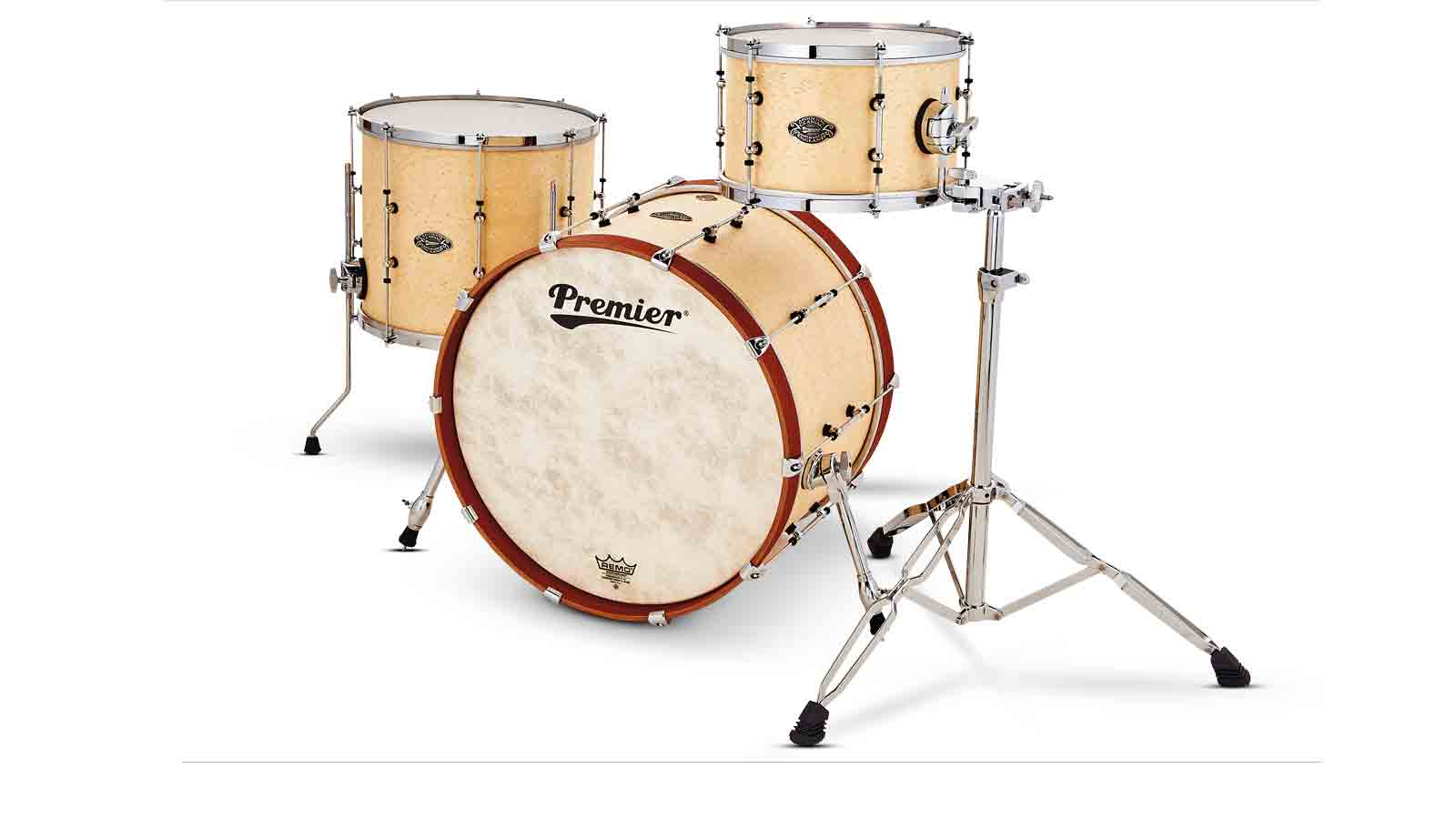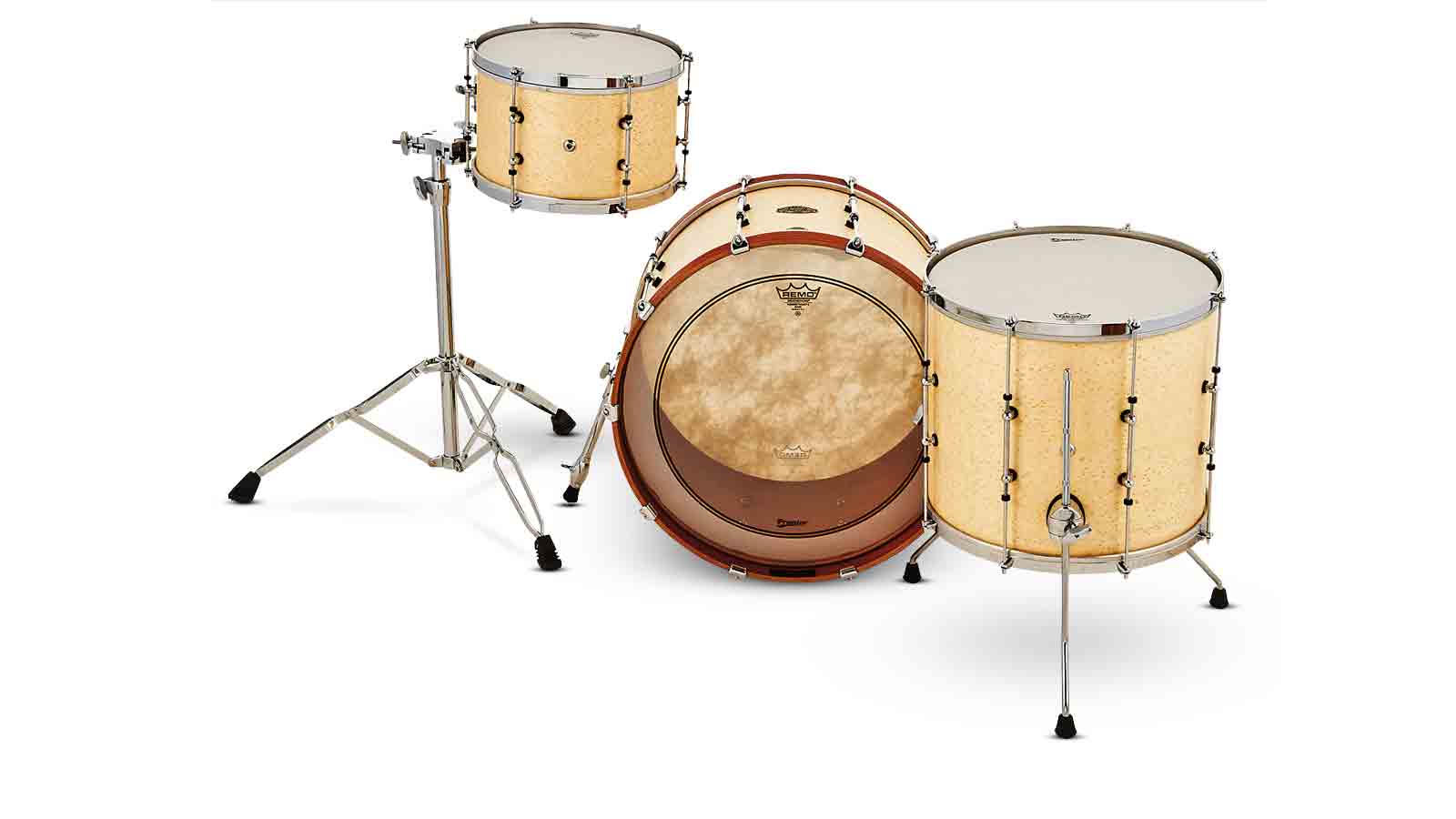MusicRadar Verdict
Not everyone will take to the retro look, but in terms of pure drum sound the Modern Classic will leave a huge smile on your face.
Pros
- +
Grin-inducing sounds. Wonderful build quality. Highly playable.
Cons
- -
Painfully retro looks may deter some players.
MusicRadar's got your back

Premier Modern Classic Concert Master 22

Rear
Premier's Modern Classics are high-end drums that are entirely hand-built in the UK. At present there is a choice of three shell packs, each consisting of three drums: the Bebop 18 and Bebop 20, which have a 12"x8" rack tom and 14"x14" floor tom coupled with an 18"x14" or 20"x14" bass drum respectively. Then there's the Concert Master 22, which comprises a 13"x8" rack tom, 16"x14" floor tom and 22"x14" bass. Here we're looking at the Concert Master 22...
Finish-wise you get mahogany or birdseye maple. Premier sent us the Concert Master 22 with the birdseye maple finish, while the bass drum has wooden hoops in mahogany. The maple is sanded to a smooth semi-matt natural finish rather than high gloss, and protected with a satin oil.
"The shells combine birch and African mahogany and are spectacularly good"
All veneers are sustainably sourced from FSC (Forest Stewardship Council) certified suppliers, and Premier adds that finishes are limited runs and will change "seasonally in accordance with market trend".
When Premier says this is a retro look, it is not kidding - in the best possible way, this kit looks like an exhibit from Rhythm's Vintage Gear section.
Retro styles are fashionable with many companies, but the Modern Classic goes further: ultra-thin shells, short tube lugs and, most unusually, flat hoops with tension clips. It's a look that was last hip in the '30s.
But there are sound reasons for all this. First is the shells, which combine birch and African mahogany and are spectacularly good. Hand-built in the factory, the toms are eight-ply yet only 4.5mm thick, while the bass drums are 11-ply yet just 6mm thick.
That is really thin, and you might expect that shells this thin would require reinforcing rings, but Keith explains that "modern glues allow us to build thinner shells without the need for re-rings".
Removing the heads and gently squeezing the shells, we were amazed how stable they remained. They barely gave a millimetre, which we put down to the large number of extremely thin cross-plies bonded with high-tech glue.
Such thin shells hark back to pre-rock days, when drummers wanted ultra-light drums to carry around on public transport, and before the advent of the massive hardware that prompted drum builders to bulk up their plies.
While the heads are off we can inspect the bearing edges. These are cut at a more gentle 30° than the standard 45°, and are rounded over with a partially flattened top - clean but not too sharp. As with everything else they are finished with the utmost care, and are sensually smooth to run your finger round.
The shell fittings are key to the retro look. Having crafted such thin shells, Premier wanted to do everything to allow them to resonate. So there are short tube lugs made in the UK from solid brass, chromed and mounted on modern isolating gaskets.
The big talking point is the chromed-steel hoops. Not triple-flanged, not double-flanged, not even single-flanged, but flat bands of thick 5mm gauge rolled steel.
These require claw-clips to hold the tension rods, again a delightfully proportioned low-mass design made from bronze, while the tension rods have steel and nylon washers.
The small tom has a mounting block for clamping to a stand, although you could just stick it on a snare stand. The floor tom has Premier's usual three legs and mounting blocks with contoured memory locks.
Completing the image, the shells bear newly designed, deeply embossed UK-made pewter badges - the standard Modern Classic badge plus an extra badge on the bass drums that reads 'Premier, The Original British Drum Company, Established 1922, Custom Works'.
Hands On
Premier drums are traditionally made from top-grade Finnish birch and, for a period in the '70s, from African mahogany. So why combine the two woods in these new hybrid shells? Keith Keough explains,
"The birch has a direct, clean sound while the mahogany calms the birch down just enough and adds warmth to the birch tones without making it sound muddy like maple or 100 percent mahogany." So, mahogany for a darker timbre and birch for focus - sounds like a smart pairing.
The question is, how does this shell configuration, along with the classic and modern design features, come together in the sound and performance? We wanted to find out if those flat, non-flanged tom hoops were a gimmick, so we grabbed the 13"x8" - and were smitten straight away. You get the sense that the flat hoops open up the sound, reducing the barrier between head and shell.
"The whole 22" shell reverberates and produces a wonderfully dark, colourful yet composed tone"
The idea of the lower profile 30°, almost- rounded edges is also to pass on a bit more shell tone. The combined effect is to get the best of both shell and head. With any drum there is always plenty of head sound, but here you really feel the connection between head and shell with minimum interference in between.
Not having played a flat-hooped tom for as long as we could remember, this effect hadn't occurred to us before - but now we're fans.
Turning to the whole kit, we have a traditional 22"x14" with updated 13"x8" and 16"x14" toms. The 13"x8" tom is an inch shallower than the traditional 13"x9", and the shortening gives it a flatter, punchier attack which suits a rock sound, reminiscent of the old 14"x8" Moonie tom but noticeably more manageable.
Likewise, cutting a couple of inches off the depth of the 16" tom quickens the response, so you still get a big tone but it's less prone to the awkward hum that sometimes bedevils a traditional 16"x16". With superb bearing edges and exceptionally circular shells, accurate tuning of all the drums is quick and easy.
Although not flanged or cast, the flat hoops are sufficiently strong and weighty at 5mm gauge to hold the tuning. They probably won't be tested by the heaviest of metal hitters, but all the drums are fitted with nylon lug locks just in case.
Because of the thick gauge and the rounding over of the steel they won't immediately chop your sticks if you catch the rims, and there's only the slightest chance of fouling your fancy stick work on the tension clips.
As for the bass drums, we have to repeat our favourite mantra: 14" deep bass drums are slowly but inevitably returning. And here is the perfect endorsement: such a crisp, almost hard slam is wholly typical of a narrow 14" drum.
The whole 22" shell reverberates and produces a wonderfully dark, colourful yet composed tone - a response you can only get from an ultra-thin and unimpeded shell.
Fitting the front heads with Fibreskyn-3 FAs (Fibreskyn Ambassador weight) makes the sound warm and dry, adding yet more depth. Those used to 16", 18" or even 20" deep bass drums may be surprised to hear just how much more cracking and focused this kick is.
Prince’s Purple Rain follow-up came out of leftfield, but did it derail his career?
GAK is gone: UK music store giant GAK just got bought by Gear4Music for £2.4 million
“It pretty much half killed us. Whether the band would continue was in the balance”: The Radiohead album that almost broke up the band, turned the music industry on its head - and became their best record









